Never miss another geomagnetic storm. Sign up for Space Weather Alerts and you'll receive a text message when magnetic storms erupt. Aurora tour guides and professional astronomers use this service. You can, too! | | |
GEOMAGNETIC STORM WATCH (UPDATED): Today's M4-class solar flare, described below, hurled a CME into space. NOAA analysts have determined that it will likely hit Earth's magnetic field during the late hours of Aug. 28th. The glancing blow could spark G1-class geomagnetic storms starting on the 28th and stretching into Aug. 29th. Aurora alerts: SMS Text
SOLAR FLARE AND CME: For the second day in a row, the sun is crackling with M-class solar flares. The strongest today, so far, is an M4-class flare from "perpendicular sunspot" AR3088. The blast sent a towering shock wave through the sun's atmosphere, recorded by NASA's Solar Dynamics Observatory:
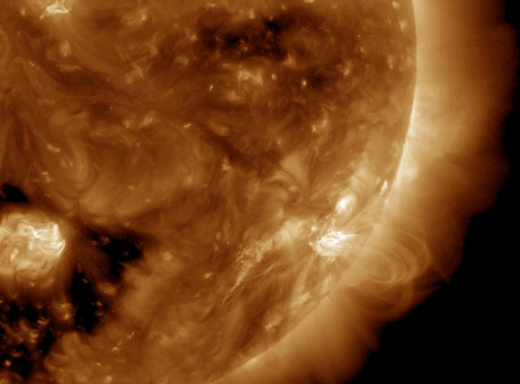
Above: The shock wave from an M4-class solar flare on Aug 27th (0240 UT).
Shock waves like this one usually hurl a CME into space. Indeed, SOHO coronagraphs have detected a CME emerging from the blast site.
NOAA forecast models suggest that the CME will sweep up another CME in front of it, possibly forming a "cannibal CME." The combined pair could sideswipe our planet's magnetic field during the late UT hours of Aug. 28th:
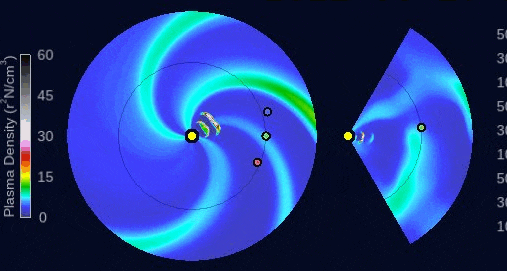
A similar NASA model shows the CME completely missing Earth. The disagreement highlights the uncertainty of the forecast. Even glancing-blow CMEs can spark geomagnetic storms, so high-latitude sky watchers should be alert for auroras on Aug. 28-29 despite the uncertainty.
Meanwhile, sunspot AR3088 is growing and seems poised to unleash an X-flare. Stay tuned! Solar flare alerts: SMS Text
Realtime Space Weather Photo Gallery
Free: Spaceweather.com Newsletter
SUMMER AURORAS IN ICELAND: Perfect timing. With a CME bearing down on Earth, midnight skies in Iceland are getting dark enough to see auroras. On Aug. 26th, Christopher Mathews photographed this display west of Seljalandsfoss:
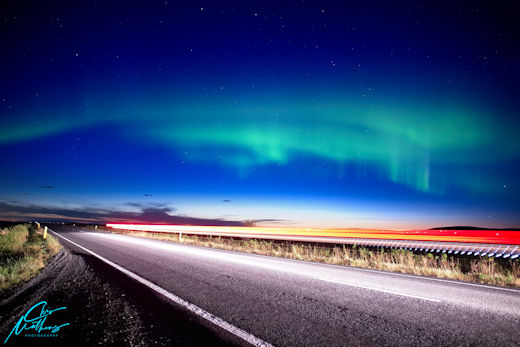
"There wasn't even a geomagnetic storm," says Mathews. "The planetary K index, Kp, was only 2. But we had clear skies and as I was driving down the road I noticed the sky turning green. I managed this shot of the road lit by a passing car and the skies lit by a passing solar breeze."
Realtime Aurora Photo Gallery
Free: Spaceweather.com Newsletter
THE VERNAL EQUINOX PEARL: Are you looking for a far-out gift? Consider the Vernal Equinox Pearl, launched to the edge of space onboard an Earth to Sky Calculus cosmic ray balloon. Here it is, floating 111,202 feet above the Sierra Nevada mountains of central California:
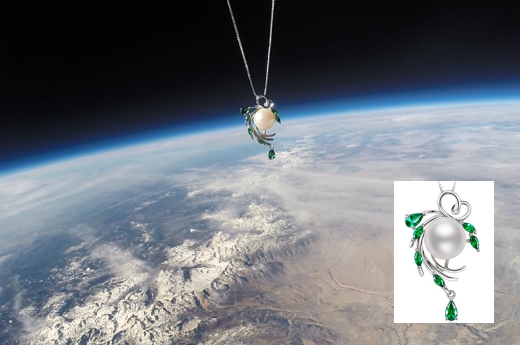
You can have it for $179.95. The 10mm cultured white pearl, surrounded by a crystalline splash of spring-green cubic zirconia, spent more than 2 hours in the stratosphere as sensors in the payload measured cosmic rays.
Each purchase comes with a greeting card showing the pearl in flight and telling the story of its journey to the stratosphere and back again.
Far Out Gifts: Earth to Sky Store
All sales support hands-on STEM education
Realtime Noctilucent Cloud Photo Gallery
Free: Spaceweather.com Newsletter
Every night, a network of
NASA all-sky cameras scans the skies above the United States for meteoritic fireballs. Automated software maintained by NASA's Meteoroid Environment Office calculates their orbits, velocity, penetration depth in Earth's atmosphere and many other characteristics. Daily results are presented here on Spaceweather.com.
On Aug 27, 2022, the network reported 17 fireballs.
(16 sporadics, 1 northern Delta Aquariid)
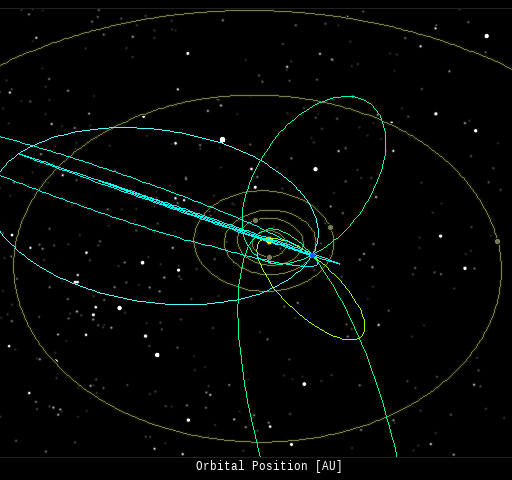
In this diagram of the inner solar system, all of the fireball orbits intersect at a single point--Earth. The orbits are color-coded by velocity, from slow (red) to fast (blue). [Larger image] [movies]
Potentially Hazardous Asteroids (
PHAs) are space rocks larger than approximately 100m that can come closer to Earth than 0.05 AU. None of the known PHAs is on a collision course with our planet, although astronomers are finding
new ones all the time.
On August 27, 2022 there were 2288 potentially hazardous asteroids.
 |
Recent & Upcoming Earth-asteroid encounters: | Asteroid | Date(UT) | Miss Distance | Velocity (km/s) | Diameter (m) |
| 2020 QW3 | 2022-Aug-22 | 14.1 LD | 18.1 | 30 |
| 2022 QT5 | 2022-Aug-22 | 10.2 LD | 9.6 | 25 |
| 2022 QM | 2022-Aug-22 | 18.8 LD | 5.1 | 20 |
| 2022 QV | 2022-Aug-22 | 2.2 LD | 21.8 | 23 |
| 2022 QH3 | 2022-Aug-22 | 1.3 LD | 9.5 | 15 |
| 2015 QH3 | 2022-Aug-22 | 5.6 LD | 7 | 14 |
| 2022 QX | 2022-Aug-23 | 7.3 LD | 12.7 | 19 |
| 2022 QO5 | 2022-Aug-24 | 9.5 LD | 11.4 | 30 |
| 2022 QR | 2022-Aug-24 | 3.6 LD | 8.6 | 13 |
| 2022 QP4 | 2022-Aug-26 | 3.7 LD | 7.7 | 13 |
| 2022 QQ4 | 2022-Aug-27 | 15.5 LD | 7.2 | 33 |
| 2022 QP3 | 2022-Aug-28 | 14.4 LD | 7.9 | 33 |
| 2022 QX4 | 2022-Aug-29 | 4.8 LD | 8.8 | 44 |
| 2017 BU | 2022-Aug-29 | 15.8 LD | 7 | 32 |
| 2022 QX1 | 2022-Aug-31 | 5.4 LD | 21.2 | 46 |
| 2021 CQ5 | 2022-Sep-01 | 8.7 LD | 13.5 | 7 |
| 2022 QB2 | 2022-Sep-01 | 10.3 LD | 15.9 | 32 |
| 2022 QN5 | 2022-Sep-02 | 2.4 LD | 13.6 | 21 |
| 2022 QU5 | 2022-Sep-05 | 19.2 LD | 7.1 | 31 |
| 2022 QF2 | 2022-Sep-11 | 19.1 LD | 8.4 | 44 |
| 2008 RW | 2022-Sep-12 | 17.5 LD | 10.2 | 98 |
| 2020 PT4 | 2022-Sep-15 | 19.7 LD | 10.8 | 39 |
| 2022 QD1 | 2022-Sep-16 | 19.5 LD | 9.5 | 72 |
| 2016 HF2 | 2022-Sep-29 | 19.2 LD | 5.6 | 21 |
| 2018 ER1 | 2022-Oct-02 | 14.7 LD | 4 | 27 |
| 2018 VG | 2022-Oct-05 | 18.5 LD | 6.7 | 12 |
| 2021 TJ10 | 2022-Oct-06 | 19.6 LD | 8.1 | 6 |
| 2006 SG7 | 2022-Oct-07 | 16.7 LD | 18.4 | 93 |
| 2013 TJ6 | 2022-Oct-07 | 11.7 LD | 14.4 | 32 |
| 2013 SL20 | 2022-Oct-14 | 6.2 LD | 12.1 | 45 |
| 2020 TO2 | 2022-Oct-15 | 1.4 LD | 12.6 | 18 |
| 2020 BD | 2022-Oct-16 | 12.1 LD | 11.4 | 20 |
| 2016 TH94 | 2022-Oct-25 | 19.1 LD | 13.5 | 43 |
Notes: LD means "Lunar Distance." 1 LD = 384,401 km, the distance between Earth and the Moon. 1 LD also equals 0.00256 AU. | | Cosmic Rays in the Atmosphere |
SPACE WEATHER BALLOON DATA: Almost once a week, Spaceweather.com and the students of Earth to Sky Calculus fly space weather balloons to the stratosphere over California. These balloons are equipped with sensors that detect secondary cosmic rays, a form of radiation from space that can penetrate all the way down to Earth's surface. Our monitoring program has been underway without interruption for 7 years, resulting in a unique dataset of in situ atmospheric measurements.
Latest results (July 2022): Atmospheric radiation is decreasing in 2022. Our latest measurements in July 2022 registered a 6-year low:
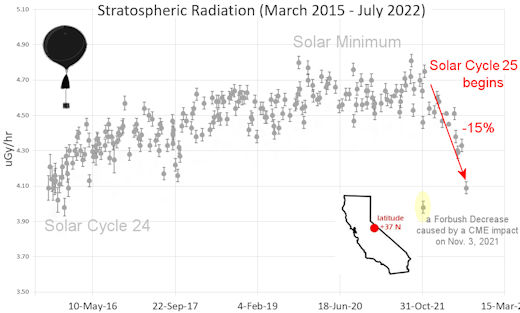
What's going on? Ironically, the radiation drop is caused by increasing solar activity. Solar Cycle 25 has roared to life faster than forecasters expected. The sun's strengthening and increasingly tangled magnetic field repels cosmic rays from deep space. In addition, solar coronal mass ejections (CMEs) sweep aside cosmic rays, causing sharp reductions called "Forbush Decreases." The two effects blend together to bring daily radiation levels down.
.Who cares? Cosmic rays are a surprisingly "down to Earth" form of space weather. They can alter the chemistry of the atmosphere, trigger lightning, and penetrate commercial airplanes. According to a study from the Harvard T.H. Chan school of public health, crews of aircraft have higher rates of cancer than the general population. The researchers listed cosmic rays, irregular sleep habits, and chemical contaminants as leading risk factors. A number of controversial studies (#1, #2, #3, #4) go even further, linking cosmic rays with cardiac arrhythmias and sudden cardiac death.
Technical notes: The radiation sensors onboard our helium balloons detect X-rays and gamma-rays in the energy range 10 keV to 20 MeV. These energies span the range of medical X-ray machines and airport security scanners.
Data points in the graph labeled "Stratospheric Radiation" correspond to the peak of the Regener-Pfotzer maximum, which lies about 67,000 feet above central California. When cosmic rays crash into Earth's atmosphere, they produce a spray of secondary particles that is most intense at the entrance to the stratosphere. Physicists Eric Regener and Georg Pfotzer discovered the maximum using balloons in the 1930s and it is what we are measuring today.
| | The official U.S. government space weather bureau |
| | The first place to look for information about sundogs, pillars, rainbows and related phenomena. |
| | Researchers call it a "Hubble for the sun." SDO is the most advanced solar observatory ever. |
| | 3D views of the sun from NASA's Solar and Terrestrial Relations Observatory |
| | Realtime and archival images of the Sun from SOHO. |
| | information about sunspots based on the latest NOAA/USAF Active Region Summary |
| | current counts of failed and deployed Starlink satellites from Jonathan's Space Page |
| | Authoritative predictions of space junk and satellite re-entries |
| | from the NOAA Space Environment Center |
| | fun to read, but should be taken with a grain of salt! Forecasts looking ahead more than a few days are often wrong. |
| | from the NOAA Space Environment Center |
| | the underlying science of space weather |
 | BestCSGOGambling is the best site for everything related to CSGO gambling on the web |
 | To find reviews of new online casino sites in the UK try The Casino DB where there are hundreds of online casino reviews complete with bonuses and ratings. Alternatively, Online-Casinos.xyz is another massive directory of online casinos listing sites for the UK and Worldwide. Casinos that offer Rupees for bonuses are very generous to Indian players. Find the best online casinos in India at AllCasinos.in Looking for a new online casino? Try Casimpo the new site dedicated to making online casino simple, or check out the new Avenger Slots Casino and Ace Online Casino with over 500 online slots and casino games. |
 | One of the most popular casino games is the Book Of Dead Slot based on ancient Egyptian text, you can find all the casinos with spins at bookofdeadslotsites.com. |
 | When looking for casinos to play online when the weather is bad, you can try casino online trucchi for Italian games. If you are not from Finland you can try the Swedish page Svenska casino online to find suitable games, check out svenskacasinoonline.net. Always check your local laws before playing with real money. |
 | Looking for sports betting companies not registered on GamStop? CasinoGap has presented a list of sites not on GamStop available for UK players. Check and bet online! Would you like to bet at sites not using GamStop? Look at a list of NonStopCasino sites for online betting that aren't on GamStop. Top-rated bookmakers ever! |
| | These links help Spaceweather.com stay online. Thank you to our supporters! |
| | | | | | |

